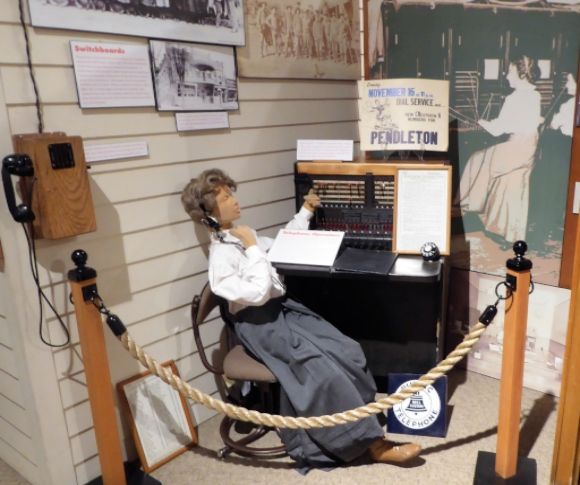For small western towns, there were three things that were important: (1) the railroad which connected them to the rest of the world, (2) a newspaper which provided a sense of community, and (3) the telephone which connected people with each other. The Heritage Station Museum in Pendleton, Oregon has displays regarding the role of newspapers and telephones in the community.
The Heritage Station Museum is operated by the Umatilla County Historical Society. In 1987, Pendleton’s 1909 train depot was acquired to be converted to a museum. The Society’s mission statement:
“The Umatilla County Historical Society was organized to collect and preserve historical objects and stories unique to the Umatilla County region and uses them to strengthen present and future generations’ understanding of that history through exhibits and diverse programming.”
Newspapers
Having its own newspaper was important in western towns for this gave the town a sense of identity, a sense of community. Generally, the newspaper publisher also served as the town’s printer, producing flyers, business cards, letterheads, greeting cards, and even books. The newspaper display in the Heritage Station Museum is shown below.






Telephones
In 1878, the first commercial telephone exchange was established in New Haven, Connecticut in which multiple telephone subscribers could connect via an operator for a monthly fee. At the end of the first month, there were 50 customers. The following year the idea of assigning the telephone customers a number emerged in which callers would ask the operator to connect with a certain number rather than giving her (operators were always women) a name.
The American Telephone and Telegraph Company was created in 1885 to operate the long distance telephone network. The number of independent telephone companies increased dramatically after the original telephone patents expired in 1893.
Shown below is the telephone exhibit in the Heritage Station Museum.

According to the display:
“From the beginning, telephone operator work was almost exclusively a female job. Operators helped customers make long distance calls, provided information and made sure the system worked smoothly.
In the early days of the telephone, it was common to refer to these workers as ‘hello girls.’ Operators manually connected calls using cable with plugs at each end. However, as the telephone became more popular, manual switching became impractical and was eventually replaced with automatic electromechanical switching devices.”




 The unusual structure shown above is a telephone booth which held a pay telephone. Once common, both telephone booths and pay telephones are now rather rare.
The unusual structure shown above is a telephone booth which held a pay telephone. Once common, both telephone booths and pay telephones are now rather rare.
According to the display:
“The first public coin telephone was installed in 1889 in a bank in Hartford, Connecticut. Coins were deposited with an attendant after the call was made. The early telephone booths were constructed of durable hardwood. They were often carpeted and included windows with screens and a ventilator.
In 1905 the first outdoor coin telephone was installed in Cincinnati, Ohio. It wasn’t an instant hit as people were reluctant to make private calls on a public thoroughfare. Glass outdoor telephone booths began to replace wooden booths in the 1950s.”
More Museums
Museums 101: The Burrows House Museum (Photo Diary)
Museums 101: The North Lincoln County Historical Museum (Photo Diary)
Museums 101: The Scots in Oregon (Photo Diary)
Museums 101: The SAGE Center (Photo Diary)
Museums 101: The Secret Life of an Artifact (Photo Diary)
Museums 101: Treasures from the Vault (Photo Diary)
Museums 101: Hagerman Valley Historical Museum (Photo Diary)
Museums 101: Transportation (Photo Diary)
Museums 101: The San Bernardino History and Railroad Museum (Photo Diary)


